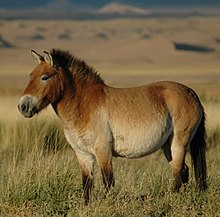Equinae: Difference between revisions
Content deleted Content added
+regulation. Tags: Mobile edit Mobile web edit Advanced mobile edit |
m improve link: tribe (biology) (via WP:JWB) |
||
| Line 7: | Line 7: | ||
|taxon = Equinae |
|taxon = Equinae |
||
|authority = {{smallcaps|Steinmann & Döderlein 1890}} |
|authority = {{smallcaps|Steinmann & Döderlein 1890}} |
||
|subdivision_ranks = [[Tribe]]s |
|subdivision_ranks = [[Tribe (biology)|Tribe]]s |
||
|subdivision = [[Equini]]<br/>[[Hipparionini]] |
|subdivision = [[Equini]]<br/>[[Hipparionini]] |
||
|synonyms = |
|synonyms = |
||
Revision as of 16:32, 25 January 2022
| Equinae | |
|---|---|

| |
| Przewalski's horse | |
| Scientific classification | |
| Domain: | Eukaryota |
| Kingdom: | Animalia |
| Phylum: | Chordata |
| Class: | Mammalia |
| Order: | Perissodactyla |
| Family: | Equidae |
| Subfamily: | Equinae Steinmann & Döderlein 1890 |
| Tribes | |
Equinae is a subfamily of the family Equidae, which have lived worldwide (except Indonesia and Australia) from the Hemingfordian stage of the Early Miocene (16 million years ago) onwards.[1] They are thought to be a monophyletic grouping.[2] Members of the subfamily are referred to as equines; the only extant equines are the horses, asses, and zebras of the genus Equus.
The subfamily contains two tribes, the Equini and the Hipparionini, as well as two unplaced genera Merychippus and Scaphohippus.
Sister taxa
References
- ^ a b Paleobiology Database: Equinae basic info.
- ^ B. J. MacFadden. 1998. Equidae. In C. M. Janis, K. M. Scott, and L. L. Jacobs (eds.), Evolution of Tertiary Mammals of North America
